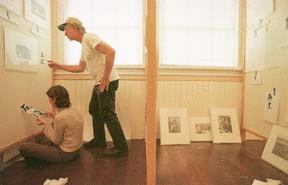The images depict, in the crisp detail that is the photographer’s hallmark, not only the bleak camp setting – the rows of shacks ringed by treeless cliffs – but the ersatz normality of such features of camp life as church services and baseball games.
The disjunctive construct of ordinary life within the concentration camp setting is captured in prints such as “Pleasure Garden,” an image of a green and tranquil Japanese garden coaxed into being against the backdrop of Mojave desert.
It is one of 49 Ansel Adams prints in an exhibit depicting Manzanar – the camp where Bainbridge residents of Japanese descent were interned during World War II – that opens next week at the Bainbridge Historical Museum.
To organizers, the display is both well-placed and timely.
“This is really the best venue and moment for this exhibit,” said Bainbridge Historical Society curator Erica Vargas. “Best place, because Bainbridge was first to have the Japanese removed for internment, and best time, not only because it’s Ansel Adams’ 100th birthday, but because of the question we ask at the end of the exhibit: Could this happen again?”
Bainbridge Historical Society Director Joan Piper brought in the exhibit with a $45,000 grant, the second-largest awarded this year by the state’s civil liberties program formed to educate citizens about the Japanese internment.
The show’s images were created when Manzanar’s second director, Ralph Merritt, invited the artist to photograph the camp in 1943.
The book of those prints, “Born Free and Equal,” was published in 1944, but an unreceptive wartime public proved more inclined to burn the pages than turn them.
The photographs lay forgotten in a storage vault at the Library of Congress until the 1980s.
When they were rediscovered, a travelling exhibit of selected works, “Manzanar: Photographs by Ansel Adams,” was curated by the Smithsonian Institution.
The 49 prints that will go on display at the historical society are arrayed on panels constructed for the occasion in an accordion-pleat arrangement dictated by the space. The works are grouped by subject, rather than esthetic considerations.
“This is his one documentary show, and we are looking at it that way,” Varga said. “It’s not visual art – we are the historical society.”
Unlike some travelling shows, the Manzanar exhibit came to the museum with framed photos and titles, but no supporting material.
It was up to Varga and exhibit designer Rick Chandler to do their own research to contextualize the exhibit.
They elected to shift the focus from the Bainbridge experience of the internment, since by 1943 many of the Bainbridge residents had been moved to another camp, and because another exhibit donated by the island’s Japanese American community addresses that subject matter.
The grant underwrites not only the exhibits, but a constellation of related activities, including production of a broadcast-quality video of Dr. Frank Kitamoto and his family’s reminiscences of internment at Manzanar.
Piper notes that it was her wish to record Kitamoto that prompted the major, grant-funded project.
“For me, it’s a lot about Frank Kitamoto,” Piper said. “He’s very central to the story. I would even say that desire to document his first-hand account drove me to go after the grant.”
Grant money will pay for Kitamoto to travel to Eastern Washington schools to speak, and pay for the transcription of audiotapes of others’ first-hand accounts of the internment, Piper says.
In addition, the grant will help fund an exhibit that describes both the internment and a wide spectrum of World War II island military and industrial efforts, which included the building minesweepers in Eagle Harbor and the interception of Japanese naval radio transmissions at Fort Ward.
“We threw a net across Rich passage to keep submarines from going to Bremerton,” Jack Klamm, former chief in charge of naval electronic equipment at Fort Word during World War II, says. “People living on Crystal Springs would see these war-damaged ships going to the shipyard. There was tremendous presence. People felt vulnerable, confused, hysterical.
“Now, we can appreciate where the wrong decisions came from,” Klamm says of the government’s internment of Japanese Americans. “That’s the beautiful thing about these exhibits – we remember, so that this time we get a chance to think it through.”
* * * * *
“Manzanar: Photographs by Ansel Adams” opens at the Bainbridge Island Historical Society, 6:30-8 p.m. Oct. 1 and will be on display for one year.
For information, call 842-2773.



